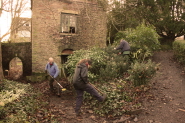Its restoration won a national award in 2004 and the University now wants the garden of the Palladian-style mansion to reflect its heritage and important place in the history of Clifton.
The resplendent house is one of the most important surviving examples of work by the architect Isaac Ware who designed it for Paul Fisher, a highly successful linen draper, merchant, and ship-owner in Bristol.
For the next century and a half, the gardens were enjoyed and altered by a series of eminent owners, until the property was donated to the University of Bristol in 1909 and Clifton Hill House opened as the first hall of residence for women in the South West.
Over 200 students now reside within the main house and in the more recent extensions, but the University wants to open up the gardens for all to see with guided tours taking place throughout the restoration project. It also hopes to unearth some interesting artefacts relating to the building’s history.
Plans for the garden’s design have been based on the 1746 ‘Survey of the Manor of Clifton’ - the first pictorial representation of Clifton drawn up by Jacob de Wilstar for the Society of Merchant Venturers. Building of Clifton Hill House began at this time.
At this point in history, Clifton was essentially a farming community but three wealthy merchant families - the Goldneys, Champions and Farrs - had moved to the cleaner air of Clifton-on-the-Hill following the growing idea of the time that the suburbs were preferable to, and more salubrious than, the bustling city.
The garden currently incorporates a number of the original trees, including tulip tress (Liriodendron tulipifera) and copper beeches (Fagus sylvatica ‘Purpurea’) along with beds of beautiful heritage roses, a large collection of magnolias and interesting herbaceous plantings.
Also present are two old stone banqueting houses, one of which stands as a ruin. These predate the house itself. Serving as a reminder of the estate’s more recent history, there remains a WWII air-raid bunker, built into a sloping bank near the house.
Alan Stealey, External Estates Manager at the University of Bristol, said: “Clifton Hill House is a wonderful building, rich with character and heritage, so we aim to create a garden to compliment this and reflect its fascinating history. We hope to attract plenty of volunteers over the winter, ready to start work on this exciting project in March. There will be a variety of opportunities, ranging from horticulture and landscaping, to administration and working to promote our project to the local community.
“The project will initially focus on the horticultural aspects of the garden design, but there may be opportunities to work with stonemasons and restoration experts as we renovate the historic outbuildings. We’re intrigued to see what artefacts are uncovered when we begin to dig, so would welcome help from those interested in archaeology or local history.”
The University is looking for volunteers with different levels of experience, who will be guided by an experienced team to work on a wide variety of tasks.
Further information is available from www.universityheritagevolunteering.org.uk. If you are interested in volunteering or finding out more, please contact Louise.Hopkins@bristol.ac.uk.
The University Heritage Volunteering project has been part-funded from various sources, including the hall, but on-going fundraising activities will need to be investigated and, if successful, there are plans to roll the project out to include other historic gardens owned by the University.

